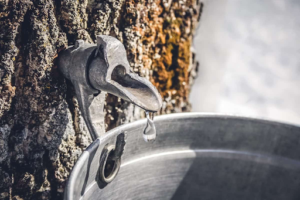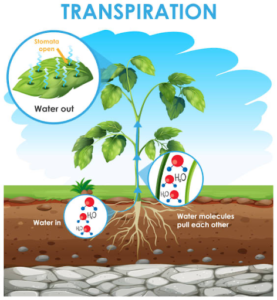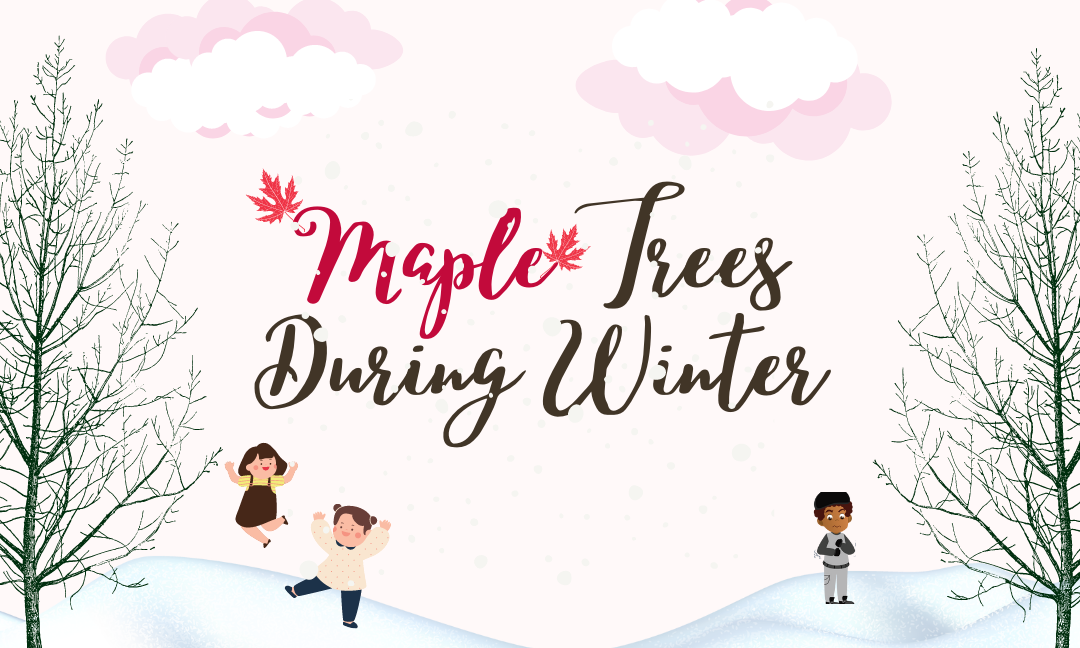Author: Anonymous
Editor: Connor Fraser
Graphic Designer: Arnav Awasthi
Publisher: Jumana Ismail
It’s maple season! Early spring is when maple trees are usually tapped for sap. But how did our favourite trees survive the bitter winter? Below are some fascinating survival techniques that help these trees thrive in severe weather conditions.

Insulation
Like the walls of a home, tree bark contains pockets of air that help prevent heat loss. The outer layer of tree bark consists primarily of non-living cells. This serves the tree in countless ways. For example, the bark is always a tree’s first layer of protection against strong winds, insects, and disease. In winter, this offers protection from freezing climates.
Abscission
Abscission is the tree’s loss of leaves. All trees lose water through their leaves in a process called transpiration. Transpiration occurs when holes in the leaves called stomata are opened by the surrounding guard cells. This allows for oxygen and water vapour to exit the stomata. Throughout the warmer seasons, water loss through transpiration encourages soil water to travel up to the leaves. But as temperatures approach freezing, the water in the ground freezes and the trees have no water source. To prevent dehydration, deciduous trees, like maple trees, lose their leaves, allowing them to conserve the water they have. However, this strategy is not shared among coniferous trees as their leaves have a smaller surface area and a waxy coating which averts water loss by this means.

Dormancy
Losing leaves help serve another function. If trees kept their leaves throughout the winter, a great deal of energy would be required to keep those leaves alive. Hence, during autumn, many trees release a chemical known as abscisic acid that triggers the fall of leaves. This is one way that trees enter dormancy. Dormant trees slow their metabolism, growth, and internal processes to conserve as much energy as possible. In the spring, trees produce energy in the form of sugar through photosynthesis. This energy is stored in their roots for the oncoming winter.

Acetic Acid
Ice Nucleators
Trees and other plants contain transport tissue called the xylem and phloem. These allow for water and nutrients to be transported to various locations in the tree. Water and nutrients travel up the xylem from the roots to the leaves. Sugars produced during photosynthesis travel down the phloem to the roots. With all this water travelling up and down a tree, ice crystals can form during winter. Ice crystals have a greater volume than water and will puncture the tree’s cells if they are formed. To avoid this scenario, trees control where this ice is formed. Trees generate proteins similar to ice nucleators, molecules that ice forms around. This allows the ice in trees to generate between their cells instead of inside them.
An Increase in Cold Tolerance
Temperature changes in mid-summer trigger an incline in trees’ tolerance to cold. By mid-winter, trees reach their maximum cold tolerance. This involves shrinkage, dehydration, and increased sugar concentration in their cells. As ice forms around a tree’s cells, water inside the cells begins leaving them. This causes the sugary sap left inside the cells to become denser. As sap has a lower freezing point than water, this better equips the tree for surviving the cold season. Furthermore, some trees tolerate cold temperatures by making their cells glasslike and immobile.
With these tactics helping them through the winter, maple trees are ready to greet spring. As daytime temperatures surpass freezing, positive pressure causes the starches stored in the roots to flow upwards to the tree’s crown. These starches are broken down into simpler sugars as they do so. Once the sugars reach the branches, the tree can form new leaves. But how does this allow us to make maple syrup? The sugar flowing through the trunk of the tree is sap. If there are any cracks or openings in the tree, this sap will flow out. In early spring, the sap can be collected from maple trees and then boiled to produce maple syrup. Boiling the sap evaporates the water and concentrates the sugars and amino acids. Sap from maple trees often contains 2-2.5% sugar. Typically, 43 gallons of sap are used in making one gallon of maple syrup. Every tap hole also provides an average of 10-15 gallons throughout the season. What might be more intriguing is that maple trees are amongst the few to produce sap that can be made into an edible form like maple syrup! Maple trees are one of a kind.
Works Cited
Bingaman, M. (n.d.). Why do maple trees produce sap? eHow. Retrieved February 24, 2022, from https://www.ehow.com/facts_7873563_do-maple-trees-produce-sap.html
Kidd, R. (2019, June 3). Why are maple trees tapped to make maple syrup? MSU Extension. Retrieved February 24, 2022, from https://www.canr.msu.edu/news/why_are_maple_trees_tapped_to_make_maple_syrup
Let’s Talk Science, & 16, M. (2020, March 16). How do trees survive in winter? Let’s Talk Science. Retrieved February 24, 2022, from https://letstalkscience.ca/educational-resources/stem-in-context/how-do-trees-survive-in-winter
Moore, T. (2017, January 28). How do trees survive winter? Lyndon Tree Care & Landscaping, LLC. Retrieved February 24, 2022, from https://www.lyndontreecare.com/educate/2017/1/28/how-do-trees-survive-winter
Perez-Watkins, M. (n.d.). How do trees survive the winter? – National Forest Foundation. National Forest Foundation. Retrieved February 24, 2022, from https://www.nationalforests.org/blog/how-do-trees-survive-the-winter
(n.d.). https://www.google.com/url?sa=i&url=https%3A%2F%2Fen.wikipedia.org%2Fwiki%2FAbscisic_acid&psig=AOvVaw2XGQ37IMKD-8NXiAhfY19k&ust=1646272074019000&source=images&cd=vfe&ved=0CAsQjRxqFwoTCJDD2sOnpvYCFQAAAAAdAAAAABAD.
(n.d.). https://www.google.com/url?sa=i&url=https%3A%2F%2Fwww.istockphoto.com%2Fphotos%2Fplant-transpiration&psig=AOvVaw2QsjLs8YXuJetzKEarYPE9&ust=1646275586528000&source=images&cd=vfe&ved=0CAsQjRxqFwoTCPjyhNC0pvYCFQAAAAAdAAAAABAD.
(n.d.). Retrieved from https://www.google.com/url?sa=i&url=https%3A%2F%2Fmorningchores.com%2Ftrees-to-tap-for-syrup%2F&psig=AOvVaw2SXi5zytyExXGh52byWHyP&ust=1646274563242000&source=images&cd=vfe&ved=0CAsQjRxqFwoTCKDMouywpvYCFQAAAAAdAAAAABAZ.

